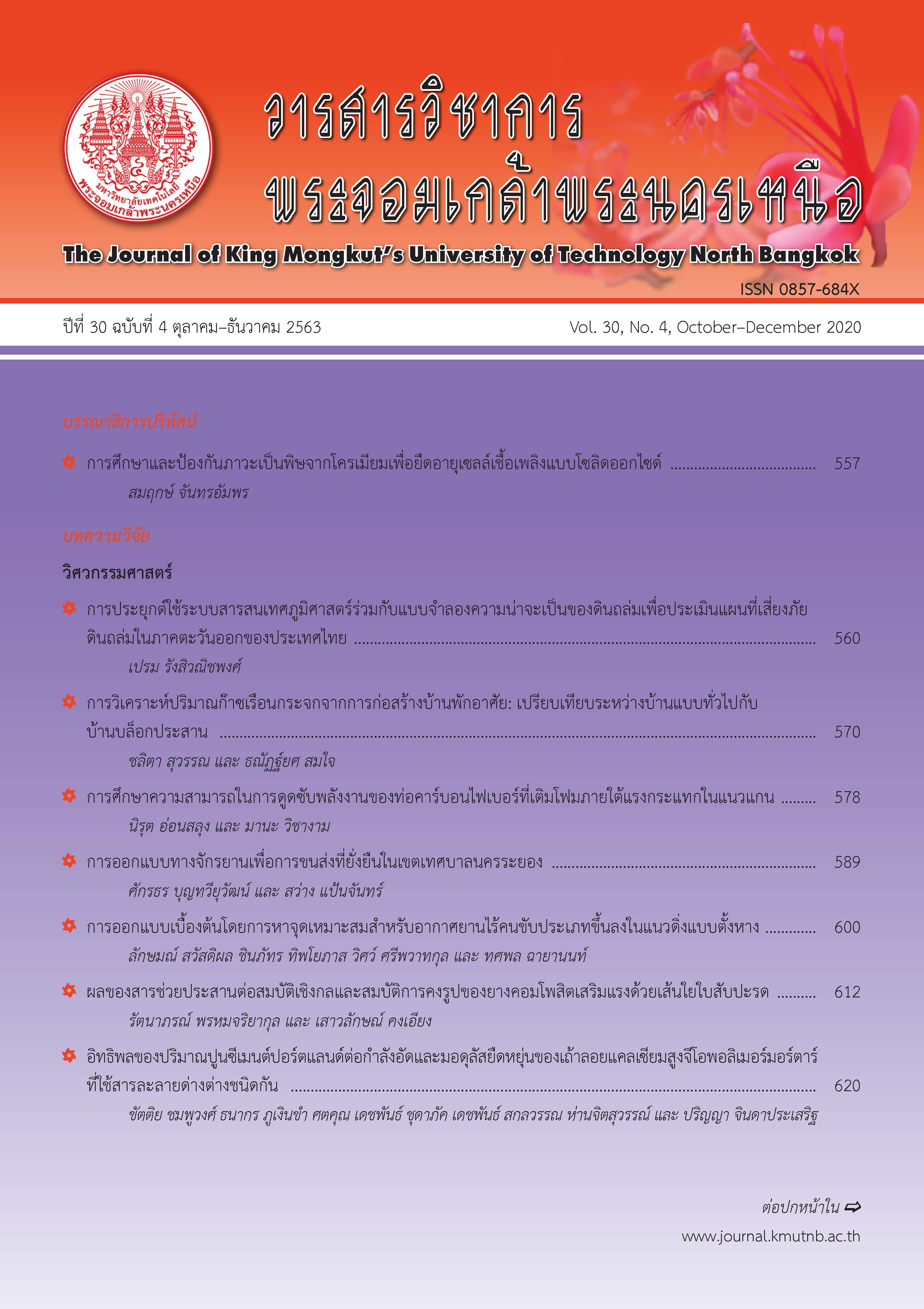การวิเคราะห์ปริมาณก๊าซเรือนกระจกจากการก่อสร้างบ้านพักอาศัย: เปรียบเทียบระหว่างบ้านแบบทั่วไปกับบ้านบล็อกประสาน
Main Article Content
บทคัดย่อ
งานวิจัยนี้มีวัตถุประสงค์เพื่อวิเคราะห์ปริมาณก๊าซเรือนกระจกที่เกิดขึ้นจากการก่อสร้างบ้านพักอาศัยต้นแบบชั้นเดียวจำนวน 2 หลัง ที่มีวัสดุผนังที่ต่างชนิดกัน ได้แก่ บ้านแบบทั่วไปที่มีผนังเป็นคอนกรีตบล็อก และบ้านบล็อกประสาน ตามหลักการประเมินวัฏจักรชีวิต ขอบเขตการวิเคราะห์ปริมาณก๊าซเรือนกระจกครอบคลุมการได้มาซึ่งวัตถุดิบ และการนำวัตถุดิบมาใช้ในการผลิตวัสดุเพื่อใช้ในการก่อสร้าง ซึ่งผลการศึกษาพบว่า ปริมาณก๊าซเรือนกระจกจากการก่อสร้างบ้านแบบทั่วไปและบ้านบล็อกประสาน มีค่าเท่ากับ 13,152.02 และ 8,322.62 กิโลกรัม คาร์บอนไดออกไซด์เทียบเท่า หรือเท่ากับ 257.88 และ 155.28 กิโลกรัม คาร์บอนไดออกไซด์เทียบเท่าต่อพื้นที่ใช้สอยของบ้าน 1 ตารางเมตร ตามลำดับ ทั้งนี้ เนื่องจากบ้านบล็อกประสานเป็นระบบผนังรับน้ำหนัก ไม่มีโครงสร้างเสาและคาน และไม่มีการฉาบผนังทั้งภายในและภายนอก จึงทำให้มีการใช้ปูนซีเมนต์และเหล็กเสริมคอนกรีต ซึ่งเป็นวัสดุที่มีการปล่อยก๊าซเรือนกระจกมากในปริมาณที่น้อยกว่าเมื่อเทียบการก่อสร้างบ้านแบบทั่วไป ผู้วิจัยเสนอแนะให้มีการขยายขอบเขตการศึกษาให้ครอบคลุมตลอดวัฏจักรของบ้านพักอาศัย โดยรวมขั้นตอนการใช้งาน และการจัดการขั้นสุดท้ายหลังอาคารหมดอายุการใช้งาน รวมถึงควรมีการประเมินประสิทธิภาพเชิงนิเวศเศรษฐกิจเพื่อให้ได้ข้อสรุปที่ชัดเจนยิ่งขึ้น
Article Details
บทความที่ลงตีพิมพ์เป็นข้อคิดเห็นของผู้เขียนเท่านั้น
ผู้เขียนจะต้องเป็นผู้รับผิดชอบต่อผลทางกฎหมายใดๆ ที่อาจเกิดขึ้นจากบทความนั้น
เอกสารอ้างอิง
[2] United Nations Environment Programme, “Towards a green economy: Pathways to sustainable development and poverty Eradication-A synthesis for policy makers,” St-Martin-Bellevue, France, 2011.
[3] H. Birgisdóttir and F. Nygaard Rasmussen, “Introduction to LCA of buildings,” Danish Transport and Construction Agency, 2016.
[4] J. T. Houghton, L. G. Meira Filho, B. Lim, K. Treanton, I. Mamaty, Y. Bonduki, D. J. Griggs, and B. A. Callander (Eds), “IPCC guidelines for national greenhouse inventories; Volume 2 Workbook,” Intergovernmental Panel on Climate Change, Paris, France, 1997.
[5] Thailand Concrete Association, “Guidelines for greenhouse gas evaluation from concrete production,” Thailand Concrete Association, Bangkok, Thailand, 2011.
[6] Thailand greenhouse gas management organization. Carbon footprint of product. Carbon Label & Carbon Footprint For Organization. Bangkok, Thailand [Online]. Available: http://thaicarbonlabel.tgo.or.th/products_approval/products_approval.pnc.
[7] K. Tachantuek, “Greenhouse gas emission assessment and economic analysis of electricity generation from Pennisetum Purpureum cv. Pakchong 1 using completely stirred tank reactor anaerobic digester,” M.S. thesis, Department of Energy Engineering, Faculty of Engineering, Chiengmai University, 2013 (in Thai).
[8] N. S. A. Asman, N. Bolong, A. K. Mirasa, I. Saad, H. Asrah, and L. C. Han, “Life cycle assessment of interlocking bricks system construction-A review,” presented at the Joint Seminar on Science, Engineering and Technology, South Korea, Apr. 2–6, 2018.
[9] N. Rungreagthanaphol, “Greenhouse gas emission from construction and operation of Bann Pracharat Project of national housing authority,” M.S. thesis, Department of Architecture, Faculty of Architecture, Chulalongkorn University, 2016 (in Thai).
[10] Thailand greenhouse gas management organization. (2019, Oct.). Greenhouse gas emission factors. Carbon Label & Carbon Footprint For Organization. Bangkok, Thailand [Online] Available: http://thaicarbonlabel.tgo.or.th/admin/uploadfiles/emission/ts_f2e7bb377d.pdf
[11] A. Korre and S. Durucan. “EVA025-Final report: Aggregates industry life cycle assessment model: Modeling tools and case studies,” The Old Academy, UK, 2007.
[12] Thai greenhouse gas management organization, “The guidelines for product carbon footprint assessment,” National Science and Technology Development Agency, Pathum Thani, Thailand, 2010.
[13] Thai greenhouse gas management organization, “The guidelines for product carbon footprint assessment,” Carbon Label & Carbon Footprint For Organization, Bangkok, Thailand, 2015.
[14] G. P. Hammond and C. I. Jones, “Embodied energy and carbon in construction materials; Inventory of carbon and energy (ICE) V.2.,” in Proceedings of the Institution of Civil Engineers - Energy, vol. 161, no. 2, 2008, pp. 87–98.
[15] M. Puettmann, E. Oneil, J. Wilson, and L. Johnson, “Cradle to gate life cycle assessment of softwood plywood production from the southeast,” The consortium for research on renewable industrial materials (CORRIM), 2013.
[16] Ng. Ruisheng, C. W. P. Shi, J. S. C. Low, H. M. Lee, and B. Song, “Comparative carbon footprint assessment of door made from recycled wood waste versus virgin hardwood: case study of a Singapore wood waste recycling plant,” Glocalized Solutions for Sustainability in Manufacturing, in Proceedings. the 18th CIRP International Conference on Life Cycle Engineering, 2011, pp. 629–634.
[17] M. Asif, T. Muneer, and R. Kelley, “Life cycle assessment: A case study of a dwelling home in Scotland,” Journal of Science Direct Building and Environment, vol. 42, pp. 1391–1394, 2007.
[18] S. Gheewala and O. Kofoworola, “Environmental life cycle assessment of a commercial office building in Thailand,” International Journal of Life Cycle Assessment, vol. 13, pp. 498–511, 2008.
[19] C. J. Koroneos, A. Th Dompros, and M. Loizidou, “Life cycle assessment of an office building in Greece,” Journal of School of Chemical Engineering, 2007.
[20] M. Boonnak, “Eco-design of dwelling home in Thailand,” M.S. thesis, Department of Energy and Environmental Technology, Faculty of Engineer, Thammasat University, 2011 (in Thai).

